Taiga Bean GoosePink-footed GooseGreater White-fronted GooseLesser White-fronted GooseGreylag GooseCanada GooseBarnacle GooseDark-bellied BrantRed-breasted GooseEgyptian Goose
Taiga Bean Goose🠉
Anser fabalis
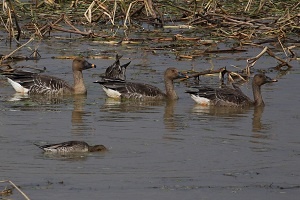
Size medium to large, fairly dark with long wings. Head and neck dark brown. Tertials and upper wing coverts dark brown with distinct white edges. Back equally dark as the flanks. Legs orange, as distinct from pink in Greylag Goose and Pink-footed Goose. Tail dark with a narrow white band at the tip. Bill orange and black (extent of the two colours variable). Some individuals may show a narrow white rim at the base of the bill. In flight, dark above and uniformly dark brown on the underwing.
Juvenile: like the adult but bill pale orange and black, narrow pale edges on the back, and flanks more uniform.
Voice: “ang-ank” or “tieu-tieu-tieu”, deep, nasal and trumpeting. Lower pitched than Pink-footed Goose.
L. 69-88 cm ; W. 140-174 cm.
Similar species : Pink-footed Goose, Greater White-fronted Goose, Lesser White-fronted Goose, Greylag Goose.
©Thomas Galewski
Pink-footed Goose🠉
Anser brachyrhynchus
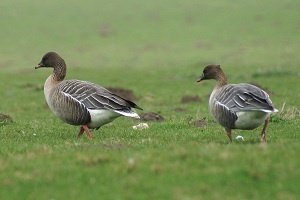
Compared with Taiga Bean Goose, slightly smaller and stockier, but size and proportions more or less the same as Taiga Bean Goose subspecies rossicus. Although their colouration is not always easy to discern, the pink legs are diagnostic. Bill small, triangular, black with a pink transverse band. Head rounded and neck relatively short. The head and the upper neck are darker than in Taiga Bean Goose (dark grey-brown) and contrast with the distinctly paler lower neck and body. Upperparts often tinged with “cold” blue-grey. Chest with a pinkish-buff tint. The rear flanks are darker than the back. In flight the Pink-footed Goose is much paler than the Taiga Bean Goose and the wings and upperparts are pale bluish-grey. The tail shows a broad white tip and not such a dark centre.
Juvenile: more uniform brown than the adult with less of a contrast between the head and upper neck and the rest of the body.
Voice: similar to Taiga Bean Goose but higher-pitched.
L. 64-76 cm ; W. 137-161 cm.
Similar species : Taiga Bean Goose, Greater White-fronted Goose, Lesser White-fronted Goose, Greylag Goose.
©Thomas Galewski
Greater White-fronted Goose🠉
Anser albifrons
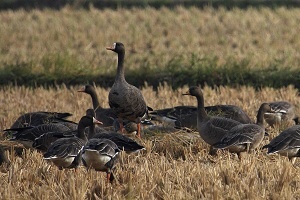
Thickset, medium-sized goose with a fairly short neck. Legs orange-red. Tail very dark and wings not extending beyond the tail.
Adult: Base of the bill white, and black barring on the belly. Can be confused with Lesser White-fronted Goose but is slightly larger and has no distinct yellow orbital ring and a heavier bill, and the white mark on the forehead does not usually extend as far as the forecrown. Bill orange-yellow or fleshy-coloured depending on the subspecies.
Juvenile: head uniform with no white, no black bars on the belly, and bill pink with a black nail.
Voice: similar to Taiga Bean Goose with higher-pitched, more musical and less nasal calls, “kyu-yu” or “kyu-yu-yu”.
L. 64-78 cm ; W. 130-160 cm.
Similar species : Lesser White-fronted Goose, Greylag Goose, Taiga Bean Goose, Pink-footed Goose.
©Thomas Galewski
Lesser White-fronted Goose🠉
Anser erythropus
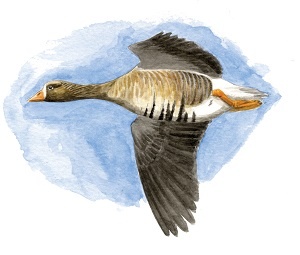
Slightly smaller than Greater White-fronted Goose. Distinguished in all plumages by a more distinct yellow orbital ring, the forehead patch reaching the forecrown and with an oblique edge when seen from the side (straighter in Greater White-fronted Goose), a smaller bill which is always flesh-coloured, plumage fairly dark with fewer bars on the belly, and long wings extending beyond the tail. Legs orange-red. In flight, wings narrow and wingbeats fast.
Juvenile: similar to Greater White-fronted Goose but on average smaller, darker and more uniform-coloured. The nail of the bill is usually pale.
Voice: like Greater White-fronted Goose but higher-pitched and more yapping.
L. 55-66 cm ; W. 115-135 cm.
Similar species : Greater White-fronted Goose, Greylag Goose, Taiga Bean Goose, Pink-footed Goose.
Greylag Goose🠉
Anser anser
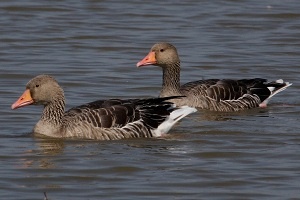
Large and heavily-built with a thick neck, a big head, and a heavy bill which is flesh-coloured or tinged with orange. Legs pink. Plumage fairly uniform grey-brown with no distinct contrast apart from broad pale fringes on the upperparts. Head and neck typically fairly pale. The flight is heavy and the wings are broad. The ash-grey forewing contrasts strongly with the dark rear wing and back. The underwing is also two-toned with the coverts mostly pale and the remiges dark. The rump is pale grey. The tail shows a broad white tip and a grey-brown centre.
Juvenile: more uniform below and more scaly above.
Voice: calls resonant, nasal and harsh: “kiyaa-ga-ga” high-pitched on the first syllable and stressed on the following syllables. Also a hoarse “ang-ang-ang”.
L. 74-84 cm ; W. 149-168 cm.
Similar species : Taiga Bean Goose, Pink-footed Goose, Greater White-fronted Goose, Lesser White-fronted Goose.
©Thomas Galewski
Canada Goose🠉
Branta canadensis
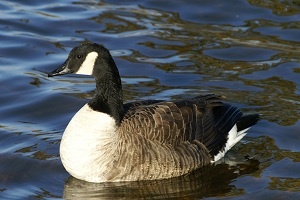
Large goose with a very long neck. Head and neck black, unlike other geese except Barnacle Goose but the eye is surrounded by black and the forehead is black. The neck is longer and the chest is pale. The wings are long and the wingbeats fairly slow.
Adult: flanks and upperparts distinctly barred buffish-white. Head and neck shining black. “Chin-strap” pure white.
Juvenile: pale barring on the flanks and upperparts less clear and more irregular. Head and neck dull brown-black. Chin-strap whitish washed with light brown.
Voice: resonant “or-loot”.
L. 90-105 cm ; W. 160-185 cm.
Similar species : Barnacle Goose, Dark-bellied Brant, Red-breasted Goose.
©Thomas Galewski
Barnacle Goose🠉
Branta leucopsis
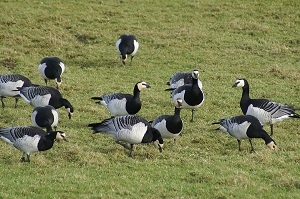
Medium size, fairly stocky with a thick short neck, a rounded head and a short bill. Head mostly white. Neck and chest black. Upperparts grey, barred with black and white. Underparts silvery-white. In flight, the black neck and chest distinguish it from the Canada Goose. The underwing is paler and the wings are a little longer.
Juvenile: differs from the adult in its darker, less clearly-marked upperparts with less white barring. The black on the neck and chest is less intense. The flanks are not as dark-barred.
Voice: a monosyllabic barking call “ka” of variable pitch.
L. 58-70 cm ; W. 120-142 cm.
Similar species : Canada Goose, Dark-bellied Brant, Red-breasted Goose.
©Thomas Galewski
Dark-bellied Brant🠉
Branta bernicla
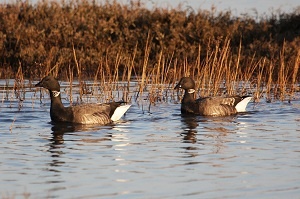
Slightly smaller and slimmer than Barnacle Goose with a slightly longer neck, a smaller less rounded head, and narrower wings. Slim and elegant in flight with pointed wings. Dark with a contrasting white rear.
Adult: uniform grey above (grey-black in the subspecies nigricans). Belly grey in the subspecies bernicla with a slight contrast with the black of the chest and neck. Belly pale with a strong contrast with the chest and neck in the subspecies hrota. Belly grey-black with no contrast with the neck and chest in nigricans but with marked contrast with the flanks, which are very broadly barred with white.
Juvenile: upper wing coverts with dirty white tips giving a barred appearance. White crescents on the neck absent in the youngest birds. Flanks darker.
Voice: resonant, nasal calls of varying pitch.
L. 55-62 cm ; W. 105-117 cm.
Similar species : Canada Goose, Barnacle Goose, Red-breasted Goose.
©Thomas Galewski
Red-breasted Goose🠉
Branta ruficollis
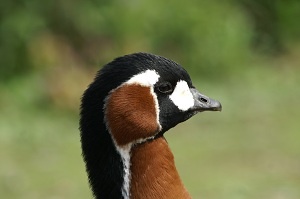
Unmistakable. Slightly smaller than Dark-bellied Brant. Thick neck and very small bill. Distinctive plumage mahogany colour, black and white. At long range, appearing dull and dark with a broad white stripe on the flanks.
Adult: only two distinct white bars on the closed wing. Large red area on the cheeks surrounded by a narrow white line.
Juvenile: 4 or 5 whitish transverse bars across the closed wing. Red area on the cheek duller and smaller, surrounded by a broad white border..
Voice: “ki-kui” or ki-yik” calls, shrill and staccato.
L. 54-60 cm ; W. 110-125 cm.
Similar species : Canada Goose, Barnacle Goose, Dark-bellied Brant.
©Thomas Galewski
Egyptian Goose🠉
Alopochen aegyptiacus
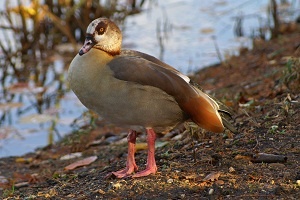
Slightly smaller than a Greylag Goose, from a distance the Egyptian Goose could be confused with the Ruddy Shelduck, especially in flight since it shows two white areas on the wings like that species. It differs from it in its sturdier build, the absence of orange tones on the body, the dark brown surround to the eye, the pale flesh-coloured bill, the long pale red legs and the dark brown pectoral patch.
Juvenile: paler, no dark pectoral mark or dark eye surround.
Voice: the male gives hoarse whistles and the female a strident “honk-haah-hah-haah”.
L. 63-73 cm ; W. 135-155 cm.
Similar species : Greylag Goose, Ruddy Shelduck.
©Thomas Galewski




.png)
